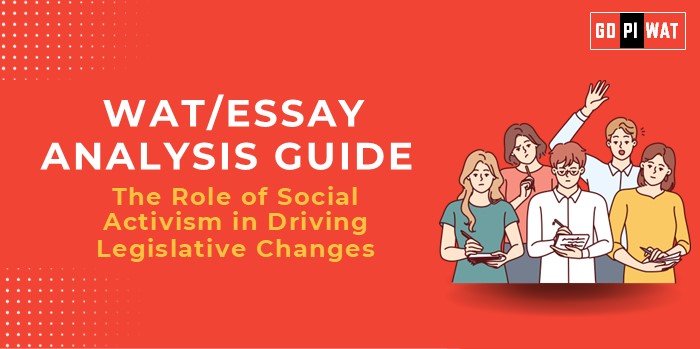📋 The Role of Social Activism in Driving Legislative Changes
🌐 Understanding the Role of Social Activism
Social activism reflects a society’s evolving priorities, offering insights into political, economic, and ethical frameworks. It serves as a crucial mechanism for highlighting social issues and pressuring institutions to enact legislative reforms.
📝 Effective Planning and Writing
- ⏱️ Time Allocation:
- 📖 Reading & Planning: 5 minutes.
- ✍️ Writing: 20 minutes.
- 🔍 Review: 5 minutes.
- 📚 Preparation Tips:
- 🔍 Research data and recent examples.
- 🌍 Understand different stakeholders’ perspectives.
✨ Introduction Techniques
- ⚖️ Contrast: “While democratic institutions promise reform, history shows activism often acts as the spark for legislative change.”
- 🛠️ Solution-Oriented: “Social movements channel collective discontent into actionable laws, bridging gaps left by traditional governance.”
- 📅 Timeline: “From women’s suffrage to LGBTQ+ rights, activism has consistently driven legislative milestones over the past century.”
📖 Structuring the Essay Body
🌟 Achievements:
- ✊ Black Lives Matter: Pushed for police reforms and heightened awareness of systemic racism.
- 🚺 Nirbhaya Protests (India): Catalyzed amendments in sexual assault laws.
⚠️ Challenges with Comparative Analysis:
- 📵 Suppression of activism in authoritarian regimes.
- 📰 Spread of misinformation undermining legitimate movements.
- 🌎 Examples:
- 🔍 Global: Crackdowns on climate protesters in some countries.
- 🇮🇳 Regional: Attempts to delegitimize farmer protests in India.
🔮 Future Outlook:
The role of technology, including social media platforms, and international coalitions will be pivotal in amplifying activism and ensuring greater global impact.
💡 Concluding Effectively
- ⚖️ Balanced: “While activism can instigate change, institutional collaboration ensures its longevity.”
- 🌍 Future-Focused: “As activism evolves, leveraging digital platforms and global solidarity can shape equitable laws.”
✍️ Sample Short Essays (100 Words Each)
1️⃣ Balanced Perspective:
Activism channels public discontent, pushing governments to enact reforms. However, without institutional backing, these reforms risk being unsustainable. A holistic approach blending activism and governance is essential.
2️⃣ Solution-Oriented:
The power of activism lies in its ability to drive awareness and influence policies. Strengthening it through digital tools can bridge gaps in representation and impact.
3️⃣ Global Comparison:
From climate protests in Europe to farmer movements in India, activism’s global resonance underscores its potential to achieve policy transformations while highlighting regional disparities.


